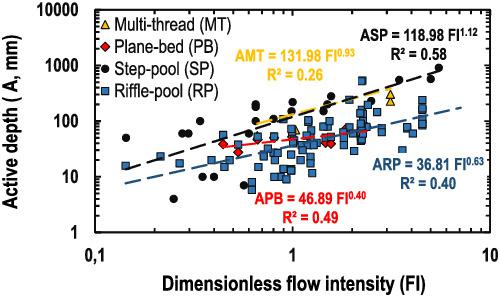当前位置:
X-MOL 学术
›
Earth Surf.Process. Land.
›
论文详情
Our official English website, www.x-mol.net, welcomes your feedback! (Note: you will need to create a separate account there.)
The active layer in gravel‐bed rivers: An empirical appraisal
Earth Surface Processes and Landforms ( IF 3.3 ) Pub Date : 2020-10-22 , DOI: 10.1002/esp.5027 D. Vázquez‐Tarrío 1, 2, 3 , G. Piqué 4 , D. Vericat 5, 6 , R.J. Batalla 5, 7, 8
Earth Surface Processes and Landforms ( IF 3.3 ) Pub Date : 2020-10-22 , DOI: 10.1002/esp.5027 D. Vázquez‐Tarrío 1, 2, 3 , G. Piqué 4 , D. Vericat 5, 6 , R.J. Batalla 5, 7, 8
Affiliation

|
The vertical position of the streambed–water boundary fluctuates during the course of sediment transport episodes, due to particle entrainment/deposition and bedform migration, amongst other hydraulic and bedload mechanisms. These vertical oscillations define a topmost stratum of the streambed (i.e. the ‘active layer or active depth’), which usually represents the main source of particles entrained during long and high‐magnitude bedload transport episodes. The vertical extent of this layer is hence a capital parameter for the quantification of bedload volumes and a major driver of stream ecology in gravel‐bed rivers. However, knowledge on how the active depth scales to flow strength and the nature of the different controls on the relation between the flow strength and the active depth is still scarce. In this paper we present a meta‐analysis over active depth data coming from ~130 transport episodes extracted from a series of published field studies. We also incorporate our own field data for the rivers Ebro and Muga (unpublished), both in the Iberian Peninsula. We explore the database searching for the influence of flow strength, grain size, streambed mobility and channel morphology on the vertical extent of the active layer. A multivariate statistical analysis (stepwise multiple regression) confirms that the set of selected variables explains a significant amount of variance in the compiled variables. The analysis shows a positive scaling between active depth and flow strength. We have also identified some links between the active depth and particle travel distances. However, these relations are also largely modulated by other fluvial drivers, such as the grain size of the bed surface and the dominant channel macro‐bedforms, with remarkable differences between plane‐bed, step‐pool and riffle‐pool channels. © 2020 John Wiley & Sons, Ltd.
中文翻译:

砾石床河流中的活动层:实证评估
在沉积物运输过程中,除其他水力和床荷机制外,由于颗粒夹带/沉积和岩床运移,河床-水边界的垂直位置会波动。这些垂直振荡定义了河床的最上层(即“活动层或活动深度”),通常代表了长期和高幅床载运输过程中夹带的颗粒的主要来源。因此,该层的垂直范围是量化床载量的主要参数,也是砾石河中河流生态的主要驱动力。然而,关于有效深度如何与流动强度成比例以及关于流动强度与有效深度之间关系的不同控制的性质的知识仍然很少。在本文中,我们对来自一系列已发表的田间研究的约130个运输事件的活动深度数据进行了荟萃分析。我们还结合了自己在伊比利亚半岛的埃布罗河和穆加河(未发布)的现场数据。我们探索数据库,以搜索流动强度,晶粒尺寸,流化迁移率和通道形态对活性层垂直范围的影响。多元统计分析(逐步多元回归)确认,所选变量集解释了已编译变量中的大量方差。分析表明,有效深度和流动强度之间呈正比例关系。我们还确定了有效深度与粒子传播距离之间的某些联系。然而,这些关系在很大程度上也受到其他河流驱动因素的调节,例如床面的晶粒尺寸和主要的河道宏床形,而在平面床,阶梯坑和浅滩坑道之间存在显着差异。分级为4 +©2020 John Wiley&Sons,Ltd.
更新日期:2020-10-22
中文翻译:

砾石床河流中的活动层:实证评估
在沉积物运输过程中,除其他水力和床荷机制外,由于颗粒夹带/沉积和岩床运移,河床-水边界的垂直位置会波动。这些垂直振荡定义了河床的最上层(即“活动层或活动深度”),通常代表了长期和高幅床载运输过程中夹带的颗粒的主要来源。因此,该层的垂直范围是量化床载量的主要参数,也是砾石河中河流生态的主要驱动力。然而,关于有效深度如何与流动强度成比例以及关于流动强度与有效深度之间关系的不同控制的性质的知识仍然很少。在本文中,我们对来自一系列已发表的田间研究的约130个运输事件的活动深度数据进行了荟萃分析。我们还结合了自己在伊比利亚半岛的埃布罗河和穆加河(未发布)的现场数据。我们探索数据库,以搜索流动强度,晶粒尺寸,流化迁移率和通道形态对活性层垂直范围的影响。多元统计分析(逐步多元回归)确认,所选变量集解释了已编译变量中的大量方差。分析表明,有效深度和流动强度之间呈正比例关系。我们还确定了有效深度与粒子传播距离之间的某些联系。然而,这些关系在很大程度上也受到其他河流驱动因素的调节,例如床面的晶粒尺寸和主要的河道宏床形,而在平面床,阶梯坑和浅滩坑道之间存在显着差异。分级为4 +©2020 John Wiley&Sons,Ltd.



























 京公网安备 11010802027423号
京公网安备 11010802027423号